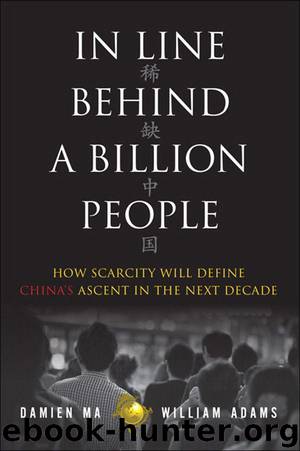In Line Behind a Billion People: How Scarcity will Define China's Ascent in the Next Decade by Ma Damien;Adams William

Author:Ma, Damien;Adams, William
Language: eng
Format: mobi
Publisher: FT Press
Published: 2013-08-13T16:00:00+00:00
Socialist property rights with Chinese characteristics
Liberalization of household registration rules would mean that “rural” Chinese are officially permitted to relocate to cities and participate in public health, education, and pension schemes. But reforms to allow rural Chinese to use their largest source of wealth—the family plot of land—to finance their lives in the cities are progressing only in fits and starts. The market for rural land is very weak. It remains owned primarily by rural collectives, and the use rights granted to rural families to farm on it are usually half the length or less of the 70 years allowed for urban residential land-use rights.24 Even more important, rural land-use rights are messy to monetize because farmers themselves are prohibited from converting agricultural land to industrial or residential use. In contrast, although the outright ownership of urban land in 2013 belongs to the state, the right to use it for development can be much more freely traded.
Converting rural land is within the exclusive domain of urban governments, who capture the huge difference in value created by the use of land in the modern economy rather than for agriculture. Without this gigantic piggybank, which for many local governments produces as much revenue as do all “on-budget” sources of income, China’s local governments could suddenly find themselves hard pressed to pay for all the new social spending obligations that a more generous welfare state and growing elderly population will impose on them.25
Just as complex will be sanctioning the enfranchisement of the migrant class into urban China. Once the choice is made, it will obligate the government to shoulder the responsibility of ensuring that migrants have an adequate place to live, likely requiring a massive public housing campaign. In fact, perhaps in preparation of this eventuality, the Chinese government has made bringing online new supplies of “social housing” a priority. By 2015, Beijing has set out to build 36 million units of affordable housing.26
As of 2012, China surpassed its targets of starting 7 million units and completing the construction on 6 million units, at least according to official statistics.27 But the process was anything but smooth. Local governments had to provide the land for affordable housing construction at no cost to developers, causing tax revenues from sales of land use rights to plummet in 2012 by 12.6% from 2011.28 As a result, local governments scrambled to offset the loss in revenue by, among other things, selling off some of their municipal auto fleets, usually composed of high-end foreign imports.29 Disgruntled local authorities who were accustomed to pulling in revenue from supporting high-end residential and commercial real estate likely complained to the central government about the affordable mandate. Pressure from local governments feeling financially put-upon may have been why the central government reduced low-income housing targets for 2013 to 6.3 million units started and 4.7 million basically completed.30 The government’s experience with affordable housing so far makes its ability to supply it for the tens of millions who want it a very open question.
The
Download
This site does not store any files on its server. We only index and link to content provided by other sites. Please contact the content providers to delete copyright contents if any and email us, we'll remove relevant links or contents immediately.
The Meaning of the Library by unknow(2390)
Six Billion Shoppers by Porter Erisman(2229)
Why Nations Fail: The Origins of Power, Prosperity, and Poverty by Daron Acemoglu & James Robinson(2180)
No Time to Say Goodbye(1998)
Red Notice by Bill Browder(1933)
The Economist [T6, 22 Thg9 2017] by The Economist(1845)
Currency Trading For Dummies by Brian Dolan(1793)
Thank You for Being Late by Thomas L. Friedman(1680)
Bitcoin: The Ultimate Guide to the World of Bitcoin, Bitcoin Mining, Bitcoin Investing, Blockchain Technology, Cryptocurrency (2nd Edition) by Ikuya Takashima(1615)
Amazon FBA: Amazon FBA Blackbook: Everything You Need To Know to Start Your Amazon Business Empire (Amazon Empire, FBA Mastery) by John Fisher(1496)
Coffee: From Bean to Barista by Robert W. Thurston(1422)
The Future Is Asian by Parag Khanna(1402)
The Great Economists by Linda Yueh(1394)
Capitalism Without Capital: The Rise of the Intangible Economy by Jonathan Haskel(1342)
Pocket World in Figures 2018 by The Economist(1329)
How Money Got Free: Bitcoin and the Fight for the Future of Finance by Brian Patrick Eha(1322)
Grave New World by Stephen D. King(1317)
The Sex Business by Economist(1283)
Cultural Intelligence by David C. Thomas(1204)
